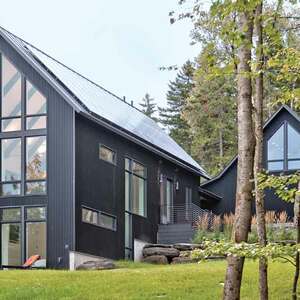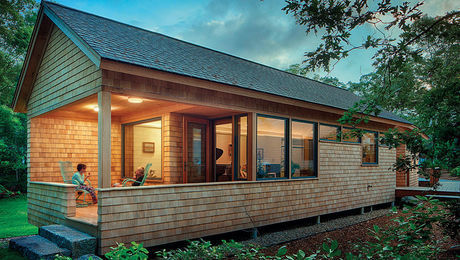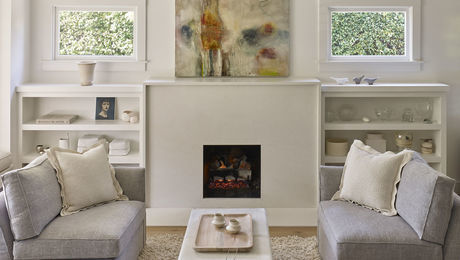How to Buy that Second Home Now
Attorney Robert Goulder examines the potential tax benefits of second homes
When it comes to real estate, Congress loves tax incentives that encourage home ownership, so much so that the popular deductions for mortgage interest and property taxes on a primary residence often are available for second homes. Throw in the possibility of additional deductions for depreciation and maintenance expenses, and second-home ownership may be the best investment you can make.
Mortgages made simple
Many types of financing are available for second homes, just as for primary residences. You can choose between 15-year and 30-year loans, and between adjustable and fixedrate notes. The best arrangement will depend on several factors, including how long you intend to keep the property, how large a down payment you have, and what size monthly payment you can afford.
Lenders traditionally subject second-home loan applications to increased scrutiny. With a higher risk of default, it’s not unusual for interest rates to run slightly higher on second homes, perhaps by as much as half a percentage point. A popular tactic is to finance a second home by tapping into the appreciation on a primary residence. A common vehicle is a home-equity line of credit, which offers the attraction of putting “found money” to productive use.
Be careful. Lenders know the housing market could decline, causing your nice cushion of found money to disappear, so it’s common for interest rates on home-equity loans to be slightly higher than rates on conventional mortgages. Many experts advise against a home-equity loan in favor of a conventional 15-year mortgage on the new property. The savings on the shorter loan period and the lower interest rate really add up.
When applying for a mortgage, you’ll likely encounter the housing-expense ratio (monthly debt service, insurance, and taxes divided by monthly personal income) or the combined-expense ratio (all monthly expenses divided by monthly personal income). Each lender has its own requirements, but it’s common for banks to set the threshold at 25% to 35%, depending on the loan package. Exceed the prescribed limit, and your loan application may be bounced.
To combat this situation, many people secure financing by planning to rent out their second home. The additional income improves their expense ratio. Don’t be surprised if lenders discount estimated rental income by about 30%. Banks factor in risks such as unexpected expenses, vacancies, or problem tenants.
When you indicate that your second home will be used for rental purposes, banks may become even tougher on your loan application because it can be difficult for lenders to trade these loans in the secondary market. Under these circumstances, banks may order a second property appraisal and request documentation of your projected rental income. If your second home is a condominium, the condo association probably is equipped to help with the paperwork.
With relatively low interest rates and abundant competition among banks, most people shouldn’t encounter too many problems locating a cooperative lender, even if the rates aren’t quite as favorable as on a first home.
Determine your second home’s status
No other economic activity enjoys such favorable tax treatment as home ownership. You can take advantage of the tax code to make a second home affordable, but the nature of the tax breaks depends on whether the Internal Revenue Service classifies your second home primarily as a personal residence or as a rental unit.
Here’s how they decide: The IRS asks if the property experiences “personal use” of more than 14 days per year or more than 10% of the total number of days it’s rented during the year, whichever is greater. If so, the property is a personal residence for tax purposes. Fail to meet this condition, and it’s considered a rental unit.
Each parcel of real estate you own is tested separately, and the results may differ from year to year. There’s no limit on the number of personal residences a taxpayer can own, although the interest deduction is limited to two personal residences.
Keep in mind that “personal use” is a technical term and does not include work days when an owner is physically on site to repair or improve the property. A spring day cleaning the gutters and opening the pool doesn’t count as personal use.
Personal use does include times the home is used by family members other than the actual owner. Lend your Uncle Harry the keys for a weekend, and that’s personal use, even if you’re hundreds of miles away. It also includes times the property is rented for less than the market rate. Say you normally rent your vacation home for $600 per week. Let a neighbor have it for only $300, and that’s considered personal use, even though you receive a payment.
Five ways a second home can affect your taxes
At this point, you’ve determined whether your second home will be treated as a personal residence or as a rental unit. The next step is to figure out the tax consequences. No matter how you use your second home, you should be able to fit your own experience into one of the following five scenarios:
1) Personal use only
First, let’s consider a second home that’s used strictly as a vacation getaway with no rental activity. The tax rules are pretty simple. In fact, they’re the same as the basic tax rules for your primary residence. Mortgage interest and property taxes are deductible for taxpayers who itemize (Schedule A of IRS form 1040). Expenses such as regular maintenance, repairs, insurance, and condo fees are not deductible.
Although you can’t deduct the maintenance expenses on a personal residence, you can benefit from certain home improvements. The costs of major enhancements, such as adding a backyard patio, can be added to your adjusted basis, lowering the capital gains you might pay when selling the place.
Two limitations on interest deductibility frequently are overlooked. Thankfully, these limits rarely apply to most people. First, the interest deduction is restricted if the mortgage debt exceeds the property’s fair market value. This is a rare occurrence because lenders go to great lengths not to be undercollateralized.
Second, you can deduct interest expense on only $1 million in aggregate mortgage debt for a primary residence and one other personal residence ($500,000 for married taxpayers filing separate returns). Home-equity loans are not counted toward the $1 million debt cap, but are subject to a separate debt cap of $100,000 ($50,000 for married taxpayers filing separately).
2) Rental only
Let’s turn things around a bit. Say you rent out your second home for the entire year. Consequently, it’s considered a rental property under the 14-day/10% test.
Because the property is viewed as a business asset held for investment purposes, almost every reasonable expense related to owning the place is tax deductible. This includes all property taxes and mortgage interest, without the $1 million cap or the two-property limit. Other deductions include management expenses, condo fees, repair costs, insurance expenses, utility charges, cleaning expenses, even commissions paid to rental agents. And don’t forget mileage charges ($0.405/mile) incurred driving to and from your property.
One of the nicest deductions for rental property involves depreciation. Even while real-estate prices surge by historic proportions, the tax code clings to the fiction that all commercial assets lose value over time and that owners of those assets must be compensated for the perceived loss.
It works like this: Look carefully at your real-estate assessment, and highlight the percentage allocation between the raw land (dirt and dandelions) and improvements (bricks and mortar). Let’s say 70% of the value is attributable to improvements, and the remaining 30% is attributable to land. The IRS permits you to depreciate that portion of your home’s acquisition cost corresponding to improvements. The depreciable amount must be spread over the property’s useful life, normally 27.5 years for tax purposes.
Sounds a bit complicated, so let’s plug in some numbers. Start with the cost of your second home; say it was $190,000. Next, factor in closing costs, such as title insurance and legal fees. Let’s say that’s an extra $8,000, for a sum of $198,000. The figure is multiplied by 0.70, reflecting the share of improvements, for a depreciable value of $138,600.
To calculate the deductible expense for a single year, the depreciable value must be spread over a useful life of 27.5 years. Using the straight-line depreciation method, we get an annual deduction of $5,040 ($138,600 divided by 27.5 years). Not too shabby, considering your property didn’t depreciate at all in real economic terms.
The only drawback is that deducting depreciation every year leads to an incrementally higher capital gain when you sell the asset. But every tax attorney will tell you it’s preferable to deduct now and pay later. The concept is called “deferral,” and it’s the best thing going—the economic equivalent of an interest-free loan courtesy of the IRS.
It gets better: Mortgage interest and property taxes are deductible on second homes held as rental properties, just as they are on vacation homes held as personal residences. But there’s a difference in how those deductions show up on your tax return. All rental income and expenses are reported on Schedule E of IRS form 1040 (Supplemental Income or Loss). For personal residences, tax-deductible expenses are reported on Schedule A (Itemized Deductions).
If this seems like an overly technical observation, consider the following: For investment property reported on Schedule E, your rental expenses can exceed gross rental income. That means you can take a net rental loss on a second home held for investment purposes. Yup, in addition to all the other deductions we’ve discussed, you’re allowed to claim deductions in excess of your income, known as a capital loss in the tax business.
There’s one catch. To inject a dose of progressivity into the tax code, the IRS limits taxpayers to a capital loss of $25,000 per year, provided their adjusted gross income is less than $100,000. As income rises, the benefit is phased out.
3) Personal residence with a few renters
Let’s say your second home is considered a personal residence under the 14-day/10% test. You’re interested in renting it out a few days each year for the extra income, but you’re not willing to take the plunge into landlord status. The law provides that a personal residence can be rented for up to 14 days without requiring the owners to declare the rental income for tax purposes. For once, the IRS simply looks the other way.
This rule is tied to the number of rental days rather than the amount of rent collected, so there’s no upper limit on the rental earnings that can be squeezed into this exception. If your home happens to be across the street from a popular event that lasts no more than 14 days (say, the Super Bowl or a major golf tournament), you could charge exorbitant rates for a short-term rental and pocket the money without paying a cent to the IRS. Everything else on your tax return is the same as if the house were for personal use only.
4) Personal residence with many renters
Congress’s generosity goes only so far. When a second home that qualifies as a personal residence is rented out for more than 14 days in a year, all rental income must be accounted for on your tax return. So think hard before renting out your second home for more than two weeks per year. The fifteenth day of rental activity has the practical effect of recapturing all 14 days of tax-free rental income you were otherwise able to enjoy.
This interplay of rules requires some strategic planning on your part. Strange as it seems, it might be in your interest to give away a few days of free or discount lodging. Remember, renting for less than market rates counts as personal use. While there’s an obvious loss of rental income, it can keep your total rental days at or below the magic number of 14 and salvage the tax benefits.
Be careful here; IRS auditors are not fools. Reasonable minds can differ as to what constitutes an arm’s-length rate and what size discount passes muster as personal use. The safest approach is to rely on your past rental history as well as on verifiable rates for comparable units. If your second home is in a condo development where other rentals have similar features, you’ve found an obvious data source for comparables.
What if your second home is well beyond 14 days of rental activity, but you still have personal residence status under the 14-day/10% rule? The problem in this scenario lies in the complexity of accounting for your real-estate expenses. Many of those expenses still can be claimed as tax deductions, but they must be allocated between personal and rental use. The former are reported on Schedule A, the latter on Schedule E.
The paperwork can be tricky, so a numerical example might help. Say you rent out your second home for six months, use it as a vacation spot for two months, and let it sit vacant for the rest of the year. Your personal use (60 days) easily exceeds the 14-day/10% test. The property is a personal residence despite the high number of rental days. This confuses people all the time, but it’s how the rule works.
Your rental income for those six months must be reported on Schedule E. The interest and property taxes must be allocated between the respective periods of rental and personal use. Some portion of the interest deduction goes on Schedule A (personal usage), and the rest appears on Schedule E (rental activity).
Crunching the numbers, we see the sixmonth rental represents half the year, so 50% of the interest and property taxes is deducted on Schedule E. Personal use is also six months (two months’ vacation, four months’ vacancy), meaning 50% of the interest and property taxes also is deducted on Schedule A.
Next, you claim the appropriate deduction for maintenance expenses, again allocating between rental and personal use. The mechanics are a bit different, though, because the vacant periods are ignored. The second home saw eight months of actual use: six months’ rental (75%), two months’ personal (25%).
In the end, Schedule E includes 100% of rental income offset by 50% of interest and property taxes and 75% of maintenance and operating expenses. You hope these deductions completely zero out your rental income. Schedule A includes itemized deductions for the remaining 50% of interest and property taxes, but none of the remaining balance (25%) for maintenance expenses, which can never be claimed on Schedule A.
5) Rental property with personal use
The final scenario involves a second home treated as a rental property for tax purposes, but that sees some personal use. Say you rent out the house for eight months (240 days) and use it as a vacation home for 20 days. Under the 14-day/10% test, this is a rental unit. You’d need a few more days of personal use for it to be a personal residence (10% of 240 is 24 days).
You must allocate your deductible expenses between rental and personal use—that should come as no surprise by now. This time, your deductions for interest, property taxes, and maintenance are allocated according to actual days used, ignoring vacant periods. The rental allocation is 240/260 (92%), and that share of the deductions is claimed on Schedule E. The personal-use allocation is 20/260 (8%), so that share of property taxes is claimed as an itemized deduction on Schedule A. Here, you cannot claim an itemized deduction for the personal share of interest expense. That’s because the home is treated as an investment property, not as a personal residence.
You’re on your way
OK, some of the rules are complicated. But most second-home expenses are deductible most of the time, so a large share of your rental income can be protected from taxes. And you might be able to depreciate the property, even if the real-world value is appreciating. Who can beat that?

























